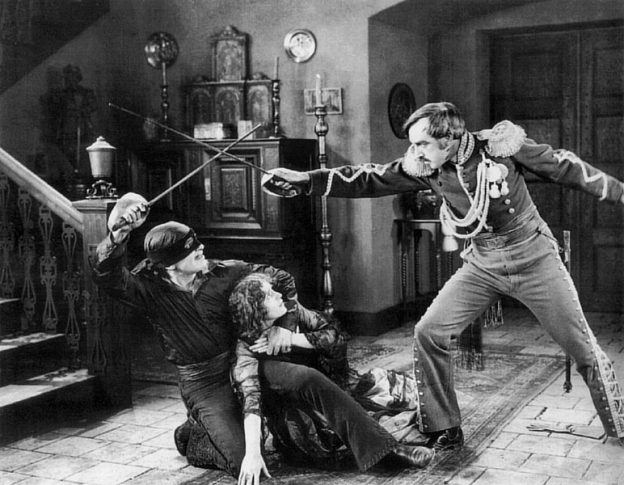Perhaps no other country has produced as many heroic movies as the United States. The Mark of Zorro (1920) directed by Fred Niblo with a wonderful acting of Douglas Fairbanks is one of the very first of such movies at the very birth of Hollywood. For me, the best thing about this movie was that, for the first time, I could enjoy watching a silent movie photographed in Sepia! This may be the result of its fast-paced story and the magnificent dual role of Fairbanks as Don Diego and Zorro. He was genuinely attached to the two characters. His ambivalence character of easygoing and fatigued persona, who enjoys handkerchief tricks and shadow playing, artistically contradicts with the athletic Zorro with all those climbing scenes and super romantic persona.
One of the main themes of this film is oppression. This movie well depicts the oppression and exploitation of the natives and the poor people of California. The movie starts with a man with a wounded face who had beat a native Californian and got revenged by Zorro. Here, natives mostly play an observer role, hidden in the background of the battle between Zorro and Capitán Juan Ramon or Sgt. Pedro Gonzales. Unfortunately “The Mark of Zorro” never depicts the obvious political conflicts between the Californians -sons of the Spanish who colonised California- and the authorities. It also missed mentioning the theme of corruption in politics and the role of the natives. It is just a symbolic showoff of a Spanish hero.
Lolita, Zorro’s love, matches the women stereotypes of its era. Lolita was in constant sorrow, longing for love, and waiting for the perfect wealthy man to arrive and conquer her heart. Although the high pace of the story suited my taste and grabbed my attention, it took away the required suspension for the viewers to feel connected with the main characters of the story. The lack of suspense makes the scene, in which Zorro won Lolita’s heart, superficial, and winning a woman’s heart a piece of cake. The lack of suspension also caused the final scene, which should have been the peak of the story, to pass quickly with no excitement. Besides, the sword battle scenes were very amateur and, at the same time, family friendly not to let anyone die to get injured.
To wrap it up, “The Mark of Zorro” had the same characteristics of Hollywood action movies. Full of shallow action scenes, pursuits and escape scenes, superficial love story, white and black, angel and evil characters. However what interests me the most is that all these ingredients have not changed over the past hundred years.
